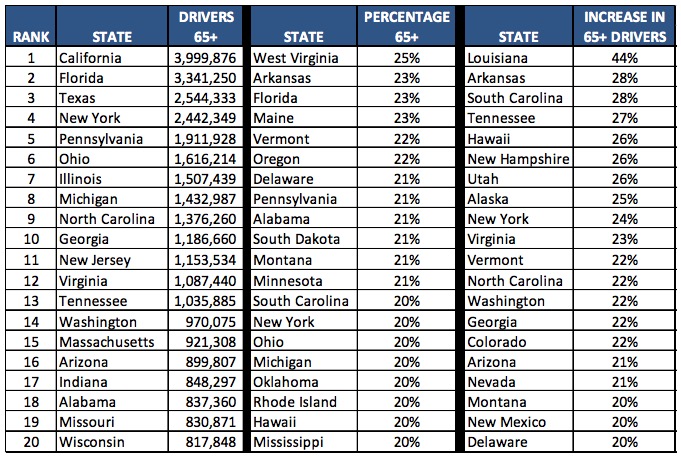TRIP
Executive Summary
 Today’s older Americans enjoy a level of mobility and an active lifestyle that far outpaces previous generations. Demographic trends indicate that the number and proportion of older Americans have increased dramatically in recent years and will continue to do so. The provision of transportation improvements that will make it easier for older American’s to maintain their mobility will benefit users of all ages. And anticipated developments in self-driving and connected vehicles have the potential to provide older Americans with additional mobility options in the future.
Today’s older Americans enjoy a level of mobility and an active lifestyle that far outpaces previous generations. Demographic trends indicate that the number and proportion of older Americans have increased dramatically in recent years and will continue to do so. The provision of transportation improvements that will make it easier for older American’s to maintain their mobility will benefit users of all ages. And anticipated developments in self-driving and connected vehicles have the potential to provide older Americans with additional mobility options in the future.
As the number and proportion of older drivers increases, roadway safety improvements designed to make it easier for older drivers to navigate traffic are becoming increasingly important, as older Americans grapple with the effects of aging while trying to maintain a level of mobility that matches their active lifestyle.
This report explores mobility and safety issues for older Americans and presents a set of recommendations for implementing a transportation system that can better serve the safety and mobility needs of older Americans and the population at large.
Older American Demographics
Older Americans form a significant proportion of the overall population and a rapidly increasing number and share of licensed drivers. The number and proportion of older Americans is expected to increase dramatically in the coming years.
- An estimated 46 million Americans are 65 or older, accounting for 15 percent of the total population. By 2060, the number of Americans ages 65 and older is projected to more than double to over 98 million, and the proportion of the total population over 65 will rise to nearly 24 percent.
- The number and proportion of licensed drivers 65 or older has surged in the last decade. From 2006 to 2016, the number of licensed drivers 65 or older has increased 38 percent – from 30.1 million in 2006 to 41.7 million in 2016. The proportion of licensed drivers 65 or older has risen from 15 percent in 2006 to 17 percent in 2012 to 19 percent in 2016.
- The number of all licensed drivers in the U.S. increased by nine percent from 2006 to 2016 from 202.8 million to 221.7 million and the number of licensed drivers less than 65 increased by four percent from 2006 to 2016 from 172.7 million to 180 million.
- The number of licensed drivers who are 65 or older increased by 16 percent from 2012 to 2016.
- The number of all licensed drivers increased by five percent from 2012 to 2016 and the number of licensed drivers less than 65 increased by two percent from 2012 to 2016.
- California, Florida, Texas, New York and Pennsylvania lead the nation in the number of licensed drivers 65 and older. West Virginia, Florida, Maine, Vermont and Arkansas lead the nation in the proportion of licensed drivers who are 65 years or older. Louisiana, Arkansas, South Carolina, Tennessee and Hawaii have seen the greatest increases in the number of licensed drivers in the last five years. The chart below details the 20 states with the highest number of licensed drivers 65 and older, the highest proportion of licensed drivers 65 and older, and the states with the largest increase in the number of licensed drivers 65 and older from 2012 to 2016. Data for all 50 states can be found in the appendix.
Fatality and Crash Rates Among Older Drivers
The number of older drivers killed or involved in fatal crashes has increased significantly in the last five years, partly due to the increasing number of older drivers and the larger share of drivers who are 65 and older.
- From 2012 to 2016, there was a 22 percent increase in the number of fatalities in crashes involving at least one driver 65 or older. The number of drivers 65 or older killed in crashes increased 21 percent from 2012 to 2016. Data for all 50 states, as well as a comparison to 2012, can be found in the appendix.
- The overall number of traffic fatalities in the U.S. increased 11 percent from 2012 to 2016, from 33,782 to 37,461 fatalities.
Older Driver Mobility and Quality of Life
Older Americans are more mobile and active than ever and want to maintain that lifestyle for as long as possible. Private vehicles remain the overwhelming transportation mode of choice for older Americans. The level of mobility enjoyed by older Americans is closely tied to their quality of life.
- For those 65 and older, 90 percent of travel takes place in a private vehicle, and for Americans 85 and older, 80 percent of travel occurs in a private vehicle.
- The majority of older Americans – 79 percent- tend to live in car-dependent suburban and rural communities, which typically require frequent, longer distance trips by automobile.
- Because they tend to limit their driving to non-peak hours (typically 9:00 a.m. to 1:00 p.m.), older drivers are disproportionately affected by growing levels of congestion. Their window of opportunity for travel narrows considerably as morning and evening rush hours become longer and midday congestion continues to grow.
- Many older drivers report self-regulating their driving by traveling only on familiar routes during daylight hours, avoiding left turns and sticking to less complex roads with lower traffic volumes during off-peak travel times.
- More than 600,000 people aged 70 or older stop driving each year and become dependent on others to meet their transportation needs. Men typically outlive their driving days by seven years and women by ten years.
- Compared with older drivers, older non-drivers in the U.S. make 15 percent fewer trips to the doctor, 59 percent fewer shopping trips and restaurant trips, and 65 percent fewer trips for social, family and religious activities.
Download full version (PDF): Preserving the Mobility and Safety of Older Americans
About TRIP
www.tripnet.org
Founded in 1971, TRIP ® of Washington, DC, is a nonprofit organization that researches, evaluates and distributes economic and technical data on surface transportation issues. TRIP is sponsored by insurance companies, equipment manufacturers, distributors and suppliers; businesses involved in highway and transit engineering and construction; labor unions; and organizations concerned with efficient and safe surface transportation.
Tags: Golden Age, Older Drivers, Retirees, safety, seniors







 RSS Feed
RSS Feed